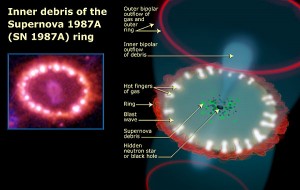The famous supernova continues to transform: its necklace of hotspots is fading away as the shock wave moves further out.

NASA / ESA / R. Kirshner (Harvard-Smithsonian CfA)
Supernova 1987A appeared in Southern skies one February night 28 years ago, a magical, serendipitous event — the first time in the telescopic age that a naked-eye supernova appeared in our night sky. You might call it “the supernova seen ‘round the world,” for the impact it had on stellar astronomy.
Observers have kept an eye on SN 1987A over the years to watch the show as it evolves. One act of the supernova’s performance is reaching its conclusion now: about two decades ago, a glowing ring of “hotspots” around the supernova's center began appearing and now, as the shock wave from the supernova moves further out, is beginning to fade.
A Dazzling Stellar Death
On the edge of the Tarantula Nebula, a mere 168,000 light-years away, lived the star formerly known as Sanduleak -69° 202. It was a blue supergiant, a type of hot, massive star rich in elements heavier than hydrogen and helium. Astronomers previously thought this type of star would not make a good candidate for a soon-to-be supernova. Clearly, they were wrong.
Before the supergiant lit up the sky, Sk -69° 202 had already proven to be unusual. It had a system of three gas rings around it: a central ring encircling its equator and two larger outer rings, one on either side of the star along a common axis — like the top and bottom of an hourglass. When the star died and the supernova began, these rings were briefly revealed by the radiation released in the explosion.
Astronomers estimated the rings had appeared approximately 20,000 years before the star died and immediately proposed a storm of theories for how the rings might have formed. Were they ejected from a collision of two closely orbiting stars, which had merged to form a single, massive star? Or had just one star, spinning like a top, flung away the rings? It was clear that understanding the ring structure would give clues to the history of the star which was now SN 1987A.

Credit: NASA / ESA / A. Feild (STScI)
The initial, dazzling glow of the supernova gradually faded over the course of several years, but in late 1994 and early 1995, astronomers noticed a bright spot on the edge of the central ring. The shell of gaseous material blown off the surface of the star at the time of the supernova, now hurtling outwards speed of 8,900,000 miles per hour, had finally arrived at the central ring, sending a powerful shock wave through the gas. The collision abruptly slowed the shock; in the densest parts of the ring, the shock wave jolted down to a velocity a tenth of its original speed. The wave passed through the denser clumps of gas in the ring, simultaneously heating and collapsing them. By 2005, these hotspots encircled the supernova in a brilliant ring of lights.
The Supernova Fades
In previous studies, researchers have measured the change in the hotspots’ visible light since 1994 to determine both the speed of the shock wave passing through the ring and the density of the clumps of gas which became hotspots.
But now the hotspots have slowly begun to fade, Claes Fransson (Stockholm University, Sweden) and colleagues report in the June 10th Astrophysical Journal Letters. The team studied images taken by the Hubble Space Telescope from 1994 to 2014, and spectra from the Very Large Telescope spanning 2000 to 2013. Based on the rate at which the hotspots are fading, the researchers predict the glittering necklace will fade away sometime between 2020 and 2030, with the calculations favoring closer to 2020. The clumps of gas in the central ring are likely dissolving, thanks to a combination of instabilities and conduction in the hot gas surrounding the clumps. In other words, the central ring is being destroyed.
However, just outside the inner ring, new, much fainter hotspots have begun to glow as the shock wave now moves through the gas beyond the ring’s bounds. As the shock wave gradually traverses the distance to the outer rings over the next several decades, it will reveal more and more of the structure between the rings. So despite destroying the central ring after one last, beautiful light show, the supernova’s shock wave will continue to provide clues as to how Sk -69° 202 and its mysterious rings were formed.
Reference: C. Fransson et al. "The Destruction of the Circumstellar Ring of SN 1987A." Astrophysical Journal Letters. June 10, 2015.
Want tips on what to look for when you look up? Get our free SkyWeek app, with daily entries and an interactive sky map set for your location.
 0
0









Comments
You must be logged in to post a comment.